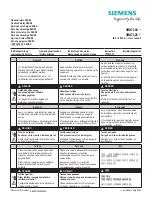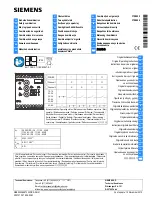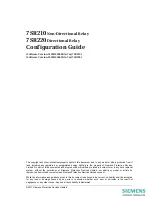
Table. 5.5.1 - 94. Pick-up settings.
Name
Range
Step
Default
Description
I
set
high
limit
0.01…40.00×I
n
0.01×I
n
1.20×I
n
Determines the pick-up threshold for phase current measurement. This
setting limit defines the upper limit for the phase current's pick-up
element.
If this condition is met, it is considered as fault and the function is not
activated.
I
set
low
limit
0.01…40.00×I
n
0.01×I
n
0.10×I
n
Determines the pick-up threshold for phase current measurement. This
setting limit defines the lower limit for the phase current's pick-up
element.
This condition has to be met for the function to activate.
I
set
ratio
0.01…100.00%
0.01%
10.00%
Determines the pick-up ratio threshold between the minimum and
maximum values of the phase current.
This condition has to be met for the function to activate.
I2/I1 ratio
0.01…100.00%
0.01%
49.00%
Determines the pick-up ratio threshold for the negative and positive
sequence currents calculated from the phase currents.
This condition has to be met for the function to activate.
The ratio is 50 % for a full single-phasing fault (i.e. when one of the
phases is lost entirely). Setting this at 49 % allows a current of 0.01 ×
I
n
to flow in one phase, wile the other two are at nominal current.
I
sum
difference
0.01…40.00×I
n
0.01×I
n
0.10×I
n
Determines the pick-up ratio threshold for the calculated residual phase
current and the measured residual current. If the measurement circuit is
healthy, the sum of these two currents should be 0.
Time
delay for
alarm
0.000…1800.000s 0.005s
0.5s
Determines the delay between the activation of the function and the
alarm.
The pick-up activation of the function is not directly equal to the START signal generation of the
function. The START signal is allowed if the blocking condition is not active. When the activation of the
pick-up is based on binary signals, the activation happens immediately after the monitored signal is
activated.
Function blocking
The block signal is checked in the beginning of each program cycle. The blocking signal is received
from the blocking matrix in the function's dedicated input. If the blocking signal is not activated when
the pick-up element activates, a START signal is generated and the function proceeds to the time
characteristics calculation.
If the blocking signal is active when the pick-up element activates, a BLOCKED signal is generated and
the function does not process the situation further. If the START function has been activated before the
blocking signal, it resets and the release time characteristics are processed similarly to when the pick-
up signal is reset.
The blocking of the function causes an HMI display event and a time-stamped blocking event with
information of the startup current values and its fault type to be issued.
The blocking signal can also be tested in the commissioning phase by a software switch signal when
the relay's testing mode "Enable stage forcing" is activated (
General
→
Device).
The variables the user can set are binary signals from the system. The blocking signal needs to reach
the device minimum of 5 ms before the set operating delay has passed in order for the blocking to
activate in time.
A
AQ
Q-S215
-S215
Instruction manual
Version: 2.04
188
Содержание AQ-S215
Страница 1: ...AQ S215 Bay control IED Instruction manual...
Страница 249: ...Figure 7 4 151 Example block scheme A AQ Q S215 S215 Instruction manual Version 2 04 248...
Страница 269: ...Figure 8 13 172 Device installation A AQ Q S215 S215 Instruction manual Version 2 04 268...
Страница 270: ...Figure 8 13 173 Panel cutout dimensions and device spacing A AQ Q S215 S215 Instruction manual Version 2 04 269...
Страница 287: ...10 Ordering information A AQ Q S215 S215 Instruction manual Version 2 04 286...
















































